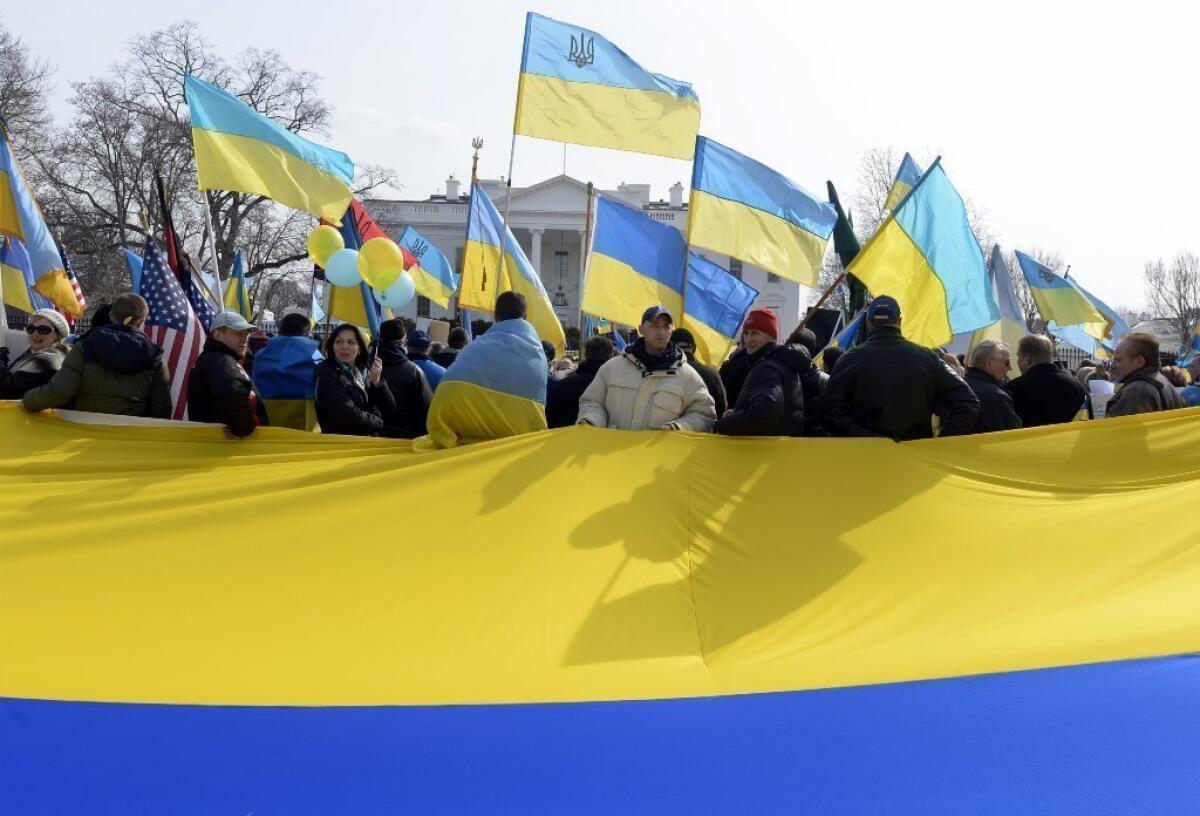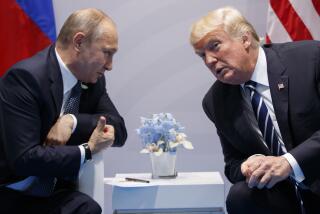Obama and the diplomacy pendulum

- Share via
When Barack Obama won the presidency in 2008, one of his selling points was the promise of a more modest foreign policy than that of his predecessor. And when Obama won reelection 16 months ago, he renewed that pledge. Drone strikes against Al Qaeda would continue, and Navy visits to the South China Sea would increase, but the U.S. footprint around the world was being resolutely downsized.
Mitt Romney warned at the time that Obama wasn’t being tough enough on Vladimir Putin, but the president scoffed at the idea that Russia was a serious geopolitical threat.
It’s not quite fair to accuse Obama of direct responsibility for Putin’s occupation of Crimea, as Sen. John McCain (R-Ariz.) and other hawkish critics have. After all, Putin invaded Georgia in 2008, when George W. Bush was president, and no one accused Bush of excessive diffidence in defending American interests.
PHOTOS: A peek inside 5 doomed dictators’ opulent lifestyles
But it’s still worth asking: Has Obama’s downsizing of U.S. foreign policy gone too far?
Stephen Sestanovich, a former State Department official under both Ronald Reagan and Bill Clinton, has addressed the issue in a useful new book called “Maximalist: America in the World from Truman to Obama.”
On foreign policy, Sestanovich writes, the U.S. tends to swing between two kinds of presidents, “maximalists” and “retrenchers.”
The maximalists — think Reagan and George W. Bush — use U.S. power, including military power, assertively. They invade other countries. They go on the offensive against those they see as adversaries. But along the way, they inevitably make mistakes, and often leave the public financially exhausted and war weary.
PHOTOS: From the Fed to GM, 5 top-tier women trying to fix man-made messes
That opens the way for the election of a retrencher (think Dwight D. Eisenhower after Harry Truman or George H.W. Bush after Reagan). They seek fewer and more limited military adventures. They cut defense budgets. They talk about engagement and diplomacy, not confrontation.
Like all broad categorizations, of course, there are exceptions. For one thing, minimalist presidents aren’t necessarily pacifists. George H.W. Bush fought a land war against Iraq’s Saddam Hussein (although he stopped short of marching to Baghdad, as his maximalist son did). Obama bombed Libya and escalated the U.S. drone war against Al Qaeda and its allies, even as he has stuck to his deadlines for withdrawing troops from Iraq and Afghanistan.
And some presidents straddle both camps. Clinton began as a minimalist, backing away from entanglement in Bosnia and elsewhere. But he soon discovered that U.S. airstrikes could accomplish what persuasion could not, and he became a proponent of what he called “diplomacy backed by force.”
PHOTOS: How the Democrats can win back the House and keep the Senate
The problem with retrenchers, Sestanovich writes, is that like maximalists, they sometimes overdo it. They back away from confrontation one time too many. They talk so much about reducing the U.S. footprint around the world that allies worry about abandonment and enemies may be emboldened. As former CIA Director George J. Tenet once said, for every action in Washington “there is an unequal and opposite overreaction.”
Obama has that problem in the Middle East, where his fervor to disengage from Iraq and Afghanistan and to deal with Iran through diplomacy has led leaders in Saudi Arabia and Israel to near-panic. Obama has steadfastly stuck to his intention to end old wars and avoid new ones, and to find cheaper ways to pursue U.S. interests abroad. “I refuse to set goals that go beyond our responsibility, our means or our interests,” he said in his 2009 speech announcing a timetable for withdrawing from Afghanistan. “We must rebuild our strength here at home.”
But all that minimalism creates a problem, Sestanovich warns: A policy based on self-restraint and fewer troops overseas can make it harder to fashion a quick, effective response when something goes wrong. “Obama’s challenge was the same faced by any president who presides over the pullback of American power: how to downsize foreign policy while retaining the ability to act decisively,” he writes.
That’s part of Obama’s challenge in Ukraine and beyond, Sestanovich told me last week.
It’s “the predicament of a retrencher,” he said. “You want to do less after a period of over-investment, but you don’t know how little will be enough to defend a scaled-back conception of American interests. The result can be brief efforts to assert American power but without much behind them, least of all a new strategy.”
Putin’s grab for Crimea would present challenges to maximalist presidents and retrenchers alike. Russia considers the territory its own and has wanted it back since the Soviet Union collapsed. European countries are hesitant to move too fast because sanctions could hurt them as well as Russia. And there’s no military option, something even Obama’s most hawkish critics concede.
For all those reasons, Ukraine is not the ideal place for Obama to begin correcting what he says is the mistaken idea that the U.S. is withdrawing from the world. But he doesn’t have much choice. If the president wants to avoid cementing the image of the United States as a weakened superpower, he needs to push back there. To paraphrase his former chief of staff, Rahm Emanuel, this is a crisis that should not go to waste.
Twitter: @DoyleMcManus
More to Read
A cure for the common opinion
Get thought-provoking perspectives with our weekly newsletter.
You may occasionally receive promotional content from the Los Angeles Times.







